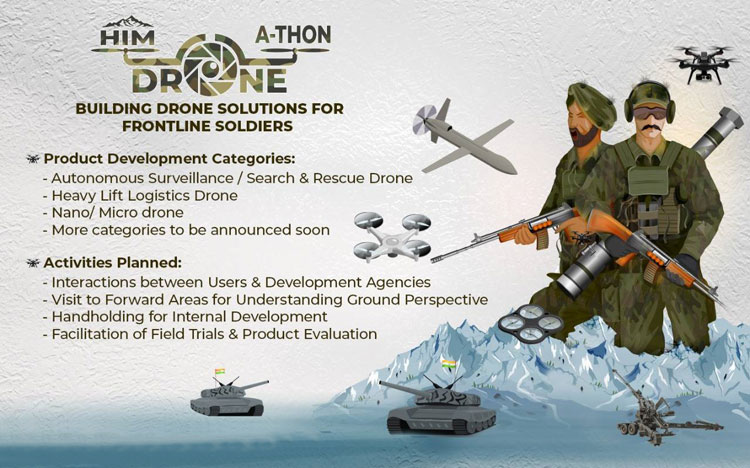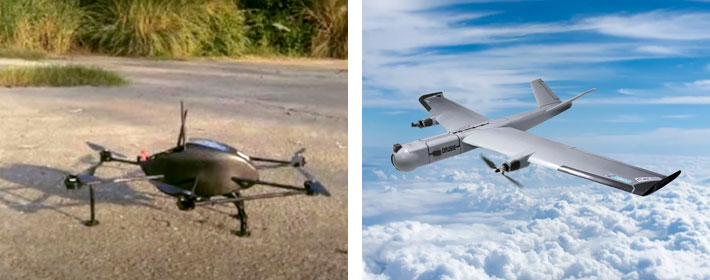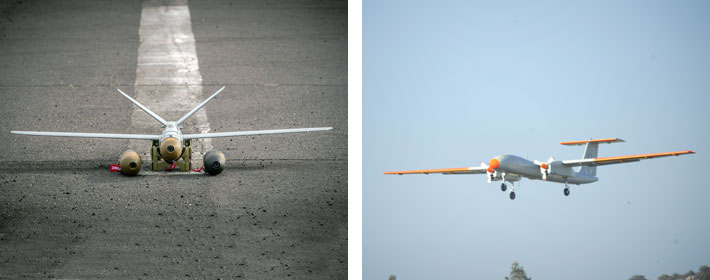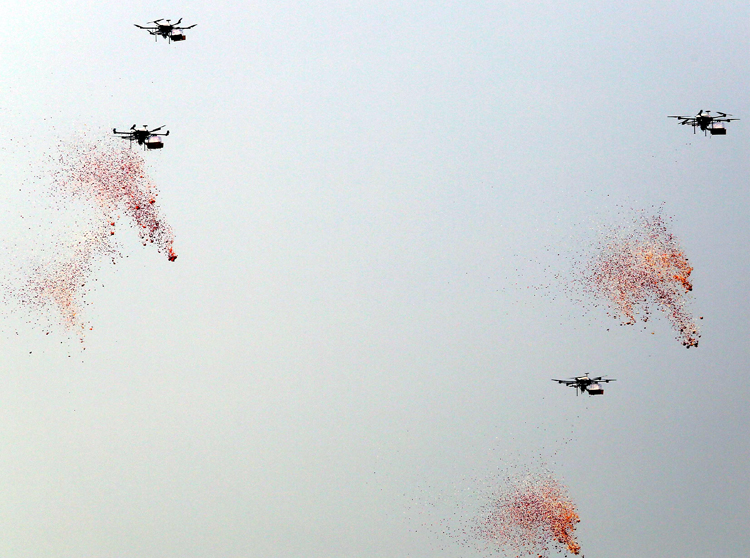INDIAN ARMED FORCES CHIEFS ON
OUR RELENTLESS AND FOCUSED PUBLISHING EFFORTS

SP Guide Publications puts forth a well compiled articulation of issues, pursuits and accomplishments of the Indian Army, over the years

I am confident that SP Guide Publications would continue to inform, inspire and influence.

My compliments to SP Guide Publications for informative and credible reportage on contemporary aerospace issues over the past six decades.
- Prime Minister witnesses 'Bharat Shakti' – a Tri-Services Firing and Manoeuvre Exercise in Pokhran, Rajasthan
- Interim Defence Budget 2024-25 — An Analysis
- Union Defence budget 2024
- Prime Minister Modi Commemorates Indian Navy Day in a Grand Ceremony
- Prime Minister Modi Flies in the LCA Tejas
- New Chapter in India-Italy Defence Ties
- Airpower beyond Boundaries
Army Seeks Large Drone Induction
The Army is seeking 1,000s of surveillance copters to be operated in the Himalayas and provide a live feed to the battle commanders. All these UAVs and RPAVs will be sourced from Indian companies. Also, the Indian Army launched the 'Him Drone-a-thon' programme aimed to catalyse and provide focused opportunities to the Indian drone ecosystem to develop drone capabilities for meeting requirements of frontline troops
 |
The Author is Former Director General of Information Systems and A Special Forces Veteran, Indian Army |

After the Chinese aggression in Eastern Ladakh in April-May 2020, the Defence Research and Development Organisation (DRDO) provided the Army with 'Bharat' drones for carrying out surveillance in high altitude areas and mountainous terrain along the Line of Actual Control (LAC). The Bharat drones have been developed by a Chandigarh-based laboratory of the DRDO. These drones provide real-time video transmission during the day and night and can also operate in swarms.
In March 2022, the Army successfully tested three different types of indigenous loitering munitions (designed and develop by Economic Explosives Ltd in partnership with the Bengaluru-based start-up Zmotion Autonomous System Pvt Ltd) in Ladakh at an altitude of over 15,000 feet. These man portable munitions with 4-kg warhead and endurance of one hour can cause disproportionate damage by homing on to conventional targets like ground-based bunkers, command centres, artillery and armoured formations.
In second week of October 2022, the Army issued two requests for proposals (RFP) to procure 363 drones in keeping with its commitment to fight future wars with indigenous solutions
Subsequently, the media reported in June 2022 that the Army has procured 100 x WARMATE Micro Loitering Munitions from Poland for the Army's Special Forces, as well as around 120 WARMATE 3.0 fixed-wing loitering munitions to equip artillery units to engage permanent and dynamic targets in plains, deserts, semi-desert, mountainous terrain and high-altitude areas. One report stated that Poland's WB Group has completed delivery of 10 sets comprising of10 launchers, 30 forward observation stations and 120 loitering munitions with a 5-year comprehensive maintenance contract.

On August 8, 2022, the Indian Army launched the 'Him Drone-a-thon' programme in collaboration with the Drone Federation of India, aimed to catalyse and provide focused opportunities to the Indian drone ecosystem to develop drone capabilities for meeting requirements of frontline troops. This programme is to enable sustained contact between all stake holders including industry, academia, software developers and drone product manufacturers. It is to be conducted in stages with quantifiable parameters (like altitude, weight, range, endurance etc) being progressively enhanced based on demonstrated capabilities.The Army has said that the gradual enhancement in technology demanded by Defence Forces is likely to incentivise manufacture of better and more capable drone products.
On October 20, 2022, the government issued a RFP for 80 x mini Remotely Piloted Aerial Systems (RPAS) which can be used for tactical surveillance. The Army would likely go for large procurement of these RPAS if they perform well.
On September 22, 2022, the indigenous ALS 50 loitering munitions developed by TATA Advanced Systems Limited (TASL) was successfully tested at Pokhran firing ranges. The ALS 50 is an autonomous system designed for Vertical Take Off and Landing (VTOL) that can operate even where limited space is available and has been successfully tested in Ladakh. It can take off like a quadcopter and transition into fixed wing mode during flight for long distance travel.

In second week October 2022, the Army issued two requests for proposals (RFP) to procure 363 drones in keeping with its commitment to fight future wars with indigenous solutions. These include 163 drones to be operable at the high altitude, while the remaining 200 will be for medium altitudes with accessories. One of the criteria that have been mandated by the Army is the availability of "60 per cent of indigenous" content.
On October 20, 2022, the government issued a RFP for 80 x mini Remotely Piloted Aerial Systems (RPAS) which can be used for tactical surveillance to locate enemy troops, equipment, and weapon systems in a particular sector. These mini RPAS, with a mission range of 15 km, is needed by artillery units for over-the-hill tactical surveillance in high-altitude areas. The Army would likely go for large procurement of these RPAS if they perform well. Besides, the Army is also seeking 1,000 surveillance copters to be operated in the Himalayas and provide a live feed to the battle commanders. All these UAVs and RPAVs will be sourced from Indian companies. The copters will provide aerial and sustained point surveillance capability to the Army. It will have a multi-sensor system to carry out real-time reconnaissance and surveillance of an area of interest.

On October 25, the Ministry of Defence (MoD) issued a RFP for 750 x Remotely Piloted Aerial Vehicles (RPAV) to be deployed with Army's Special Forces Battalions. The procurement is under the Emergency Procurement through the Fast Track Procedure (FTP). The categorisation of procurement is under the Buy (Indian) category.The indigenous content requirement for this proposal is at least 60 percent, and if indigenous design minimum of 50 per cent. The RFP reads: 'The current volatile situation along Northern orders warrants expeditious procurement of operational equipment. RPAV is a potent situational awareness device which provides surveillance by day and night along with the ability to scan the target area and provide a processed 3D scanned image of the target to execute special missions." These RPAVs are to enable the Army Special Forces to conduct pin-point precision strikes during direct action tasks such as raids, elimination of High-Value Targets (HVT), and Command and Control (C2) elements, including enemy leadership.
On October 25, the Ministry of Defence (MoD) issued a RFP for 750 x Remotely Piloted Aerial Vehicles (RPAV) to be deployed with Army's Special Forces Battalions. These RPAVs are to enable the Army Special Forces to conduct pin-point precision strikes.
In May 2018, the then Chairman DRDO S Christopher had announced that the Rustom-II Unmanned Aerial Vehicle (UAV), being developed by the DRDO will be delivered to the Armed Forces by 2020. Christopher was speaking to the media on the sidelines of the 10th convocation ceremony of the Defence Institute of Advanced Technology (DIAT), a technological university of the Ministry of Defence. Christopher is also the chairman of the Governing Council of the DIAT. Apparently, delivery of Rustom II to the Armed Forces is delayed.
There is no doubt that the Chinese aggression in Ladakh during April-May 2020 has woken up India to the requirements of the modern battlefield. More than the conflict in Ngorno-Karabakh, the ongoing war in Ukraine has brought home the damage that drones can cause especially when deployed in swarms. The future of warfare would necessarily be technology driven and drones will play an important role to enhance the operational preparedness of our Armed Forces acting by as important force multipliers.





